

The Annual Agrovista Technical Conference took place this week at Brands Hatch in Kent
In truth it wasn't quite Brands Hatch, but the Mercure Hotel at the entrance to the race circuit; there was I dreaming of a 'quick lap' of the track.....'no chance' - however it took me back to my childhood, when Brands Hatch was still a 'grass track' and a friend of my Dad; Tom Turk was the top grass track racer in England and we would spend many a summer's weekend following him around the grass tracks in the South of England.
Below: Tom Turk
 I remember Tenterden, Barham and particularly Brands Hatch. Now we are talking about the late 1940's and my particular memories are of Tom (always number 8) coming down the home straight and taking off over a hump at 90mph (he was not aware of his wheels leaving the ground) - Tom was one of my boyhood heroes then and number 8 is still my favourite number (by coincidence we now live at number 8) - my second abiding memory was my Mum's new potatoes which we had with our picnic lunch; she always filled a large kilner jar with delicious new potatoes in salad cream.....fantastic!
I remember Tenterden, Barham and particularly Brands Hatch. Now we are talking about the late 1940's and my particular memories are of Tom (always number 8) coming down the home straight and taking off over a hump at 90mph (he was not aware of his wheels leaving the ground) - Tom was one of my boyhood heroes then and number 8 is still my favourite number (by coincidence we now live at number 8) - my second abiding memory was my Mum's new potatoes which we had with our picnic lunch; she always filled a large kilner jar with delicious new potatoes in salad cream.....fantastic!
Below: Brands Hatch - extracts from Wikpedia
"Motorcycle racing quickly resumed after World War II and in 1947, Joe Francis (managing director of Brands Hatch Stadium Ltd.) persuaded the BBC to televise a grass track meeting, the first motorcycle event to be televised on British TV. Following World War II, cinders were laid on the track of what was by then known as Brands Hatch Stadium and motorcycle racing continued.
That was until 1950 when the 500 Club managed to persuade Joe Francis (managing director of Brands Hatch Stadium Ltd.) that the future for his stadium lay in car and motorcycle road racing. The group behind 500 c.c. single-seater racing cars was the 500 Club and it, together with the owners, invested the sum of £17,000 on a tarmac surface.
Thus Brands Hatch was born as a motor racing venue, and on 16 April 1950, the opening meeting was scheduled for the first purpose-built post-war racing circuit in England, approval having been given by the RAC following a demonstration by a handful of 500s in February. Amongst those giving the demonstration was a very young Stirling Moss. The Half-Litre Car Club for 500 cc Formula III organised that first race on 16 April, with 7,000 spectators coming to witness these cars complete in 10 races. The first victory went to a man who was to become a legend in Formula III, Don Parker.
Tom Turk
In 1951 Tom took over his father's small transport business and in the early days collected our apples and transported them to the London wholesale markets; in time Tom built Turks Transport into a formidable concern operating from Weavers at Iden Green near Benenden in Kent. Always in love with motor transport, Tom collected vintage vehicles; one was a rather splendid old Fire Engine, but the star attraction a DB4GT/0188/L-1961 Aston Martin DB4GT Zagato.
 DB4GT/0188/L-1961 Aston Martin DB4GT Zagato. Only car with upright, exposed headlights and the windows on 188/L are completely glass instead of Perspex. This car was probably displayed by Zagato themselves at the at the Belgium Motor Show.
DB4GT/0188/L-1961 Aston Martin DB4GT Zagato. Only car with upright, exposed headlights and the windows on 188/L are completely glass instead of Perspex. This car was probably displayed by Zagato themselves at the at the Belgium Motor Show.
Originally silver, this car was heavily modified in the 1970s by R.S. Williams's workshop to accommodate a DB6 engine, dark blue paint and a conversion to right hand drive. By 1983/4 the car was bright red and refitted with the original engine. Before being shipped to a new owner in California, R.S. Williams reconverted it to left-hand drive.
It stayed in America for some time until a thorough restoration was performed in 1992 for Tom Turk of England. For a long time it was offered as part of the Blackhawk Collection and displayed by them at the 2007 Pebble Beach Concours d'Elegance.
The Agrovista Conference is held annually and allows growers an opportunity to spend a winter's day catching up with technical advancements important to the management of their business.
Chairing the day's event - Senior Agrovista Agronomist Paul Bennett.
In this week's English Apple Man Journal I will review two of the presentations; Alex Radu updating GCI and Dr.Louisa Robson-Boyer's Mycorrhizal Fungi presentation.
Alex Radu - Agrovista Agronomist
The first presentation by Alex Radu was an update on the operational aspects of GCI (Growers Choice Interactive) software which gathers critical data and forecasts when pest or disease issues are at critical levels, allowing growers to make accurate assessments of 'what & when' to spray either fungicides or insecticides.
In order to control pest & disease in our apple orchards with the minimum use of chemicals, while ensuring the least intrusion on the environment and friendly insects, it is now common for growers to use GCI or similar forecasting software. GCI is available to Agrovista's grower base.
Below: Alex Radu's opening slide - and - a summary of GCI benefits
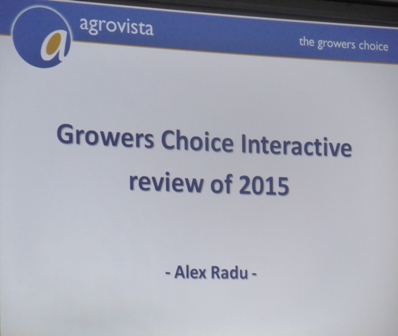
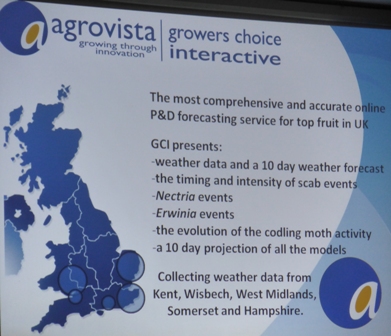
Below: Improvements made during 2014 - and - 2015 Weather profile
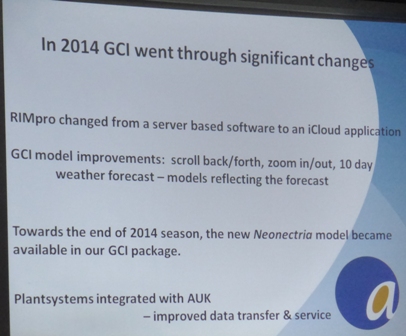
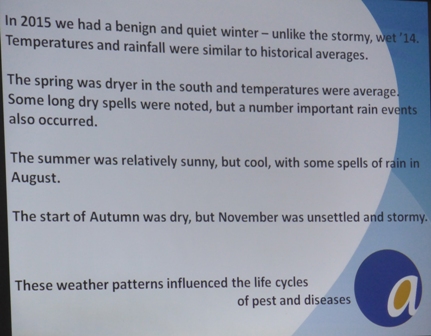
Weather of course varies from region to region and this is recognised by the GCI model; data from Kent, Wisbech, West Midlands, Somerset and Hampshire add strength to the model, which can be clearly seen by differences in the timing and occurrence of scab infection periods....
Below: demonstration of data for scab infection - and - a sawfly data model
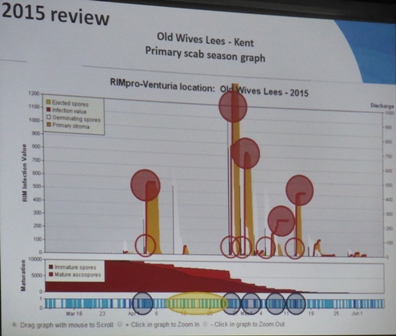
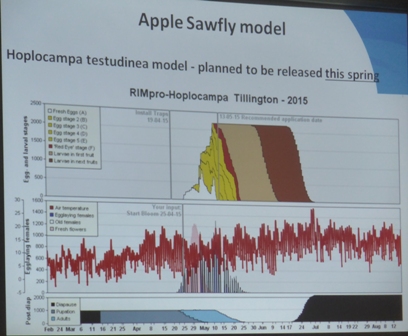
While weather forecasting is a critical element in controlling scab in apples and pears, other very important pests can be controlled more efficiently using monitoring traps to determine when eggs are laid and hatch, and when the pest damages the host plant (fruit) - by understanding the timing of each important pest's life cycle, action taken is much more effective. Control is increasingly by the introduction of key predators, or timing the application of a pest specific pesticide. By using GCI growers are able to control pest and disease with the minimum intervention of a pesticide; saving unnecessary cost and taking care of the environment.
Mycorrhiza...
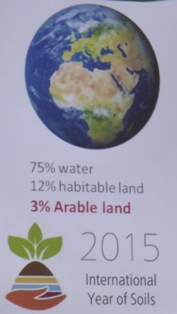 Dr.Louisa Robinson-Boyer 'Mycorrhizal Fungi'
Dr.Louisa Robinson-Boyer 'Mycorrhizal Fungi'
The Food Security Challenge - To produce more food globally between 2000 & 2050 than between 1500 AD and 2000....
Global crop yields are not growing fast enough, to feed the projected population in 2050, food production in developing countries needs to double!
The importance of global soil sustainability is measured by the fact that available arable land only contributes 3% of the world's surface.....
Louise told the attendees she works for Plantworks Ltd which was formed in 2000 as a spin out of the international institute of biotechnology....Plantworks established production of Mycorrhiza in 2006......the company has a science team of six, including Phd's in Mycology, Bacteriology and degrees in plant science, horticulture and soil sciences......Plantworks is based at The Kent Science Park occupying 6,000 sq ft feet of glasshouse and 7000 sq ft of office and manufacturing space + an important presence at East Malling Research. Louise spends her time equally between the Kent Science Park and EMR.
Up until 2014 all mycorrhiza production was targeted at the amenity horticulture; in 2014 Plantworks Ltd introduced a 'farming' proposition. While the importance of soil sustainability has been high on the agenda in recent years, it is not a new subject for discussion - the presence of Mycorrhiza in soil has been traced back in fossils for millions of years.
Below: 'Presidential concern - and - Mycorrhiza over millions of years
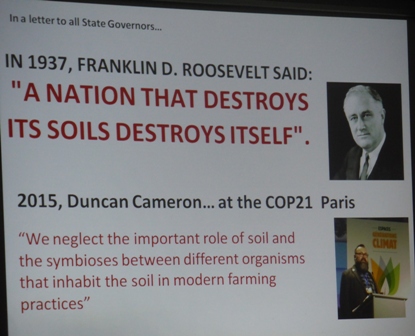
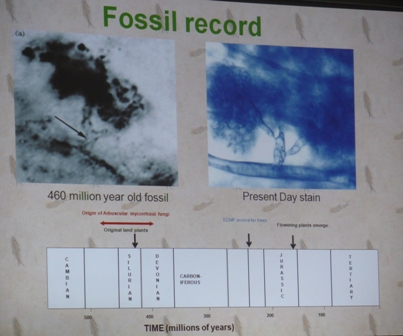
Mycorrhiza depends on a symbiotic relationship with a plant; the fungus obtains sugars from the plant while the plant benefits from a more efficient uptake of mineral nutrients and water.
A few plant families do not form mycorrhizas, notably the cabbage and beet families.
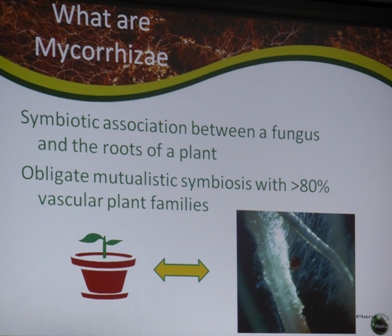
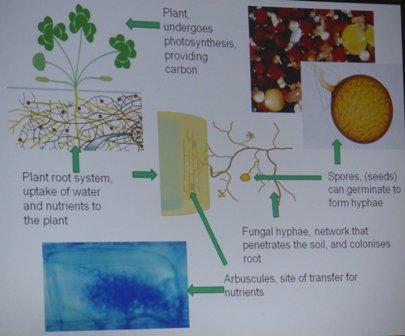
There are various types of Mycorrhiza, each has a symbiosis with a different set of plant types; Arbuscular mycorrhizas are commonly found on most plants and trees - mycorrhiza cannot survive without the presence of a host plant.
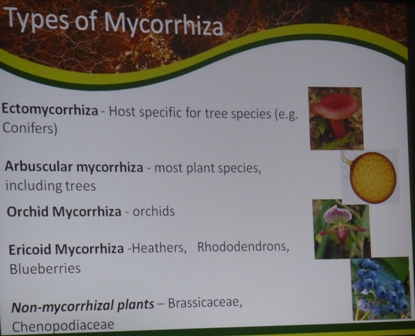
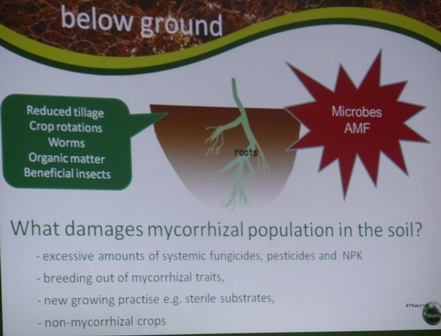
Maintaining microrrhiza in the soil depends on very careful soil management; excessive use of systemic fungicides, pesticides and NPK - while reduced cultivation, increase in organic matter and earthworms and beneficial insects improve the sustainability of mycorrhiza and the soil structure......
Clearly Mycorrhiza is playing an integral part in new orchard establishment with the introduction of micorrhiza and slow release fertilizer in the plant hole when new orchards are planted. In a question about fertilizer neutrolosing the mycorrhiza Dr. Louise Robson-Boyer emphasised the importance of any fertilizer used at planting must be a 'slow release' material.
Its not just in the soil that mycorrhiza improves plant performance; Louise presented evidence of mycorrhiza inclusion in coir bags giving an improvement in Strawberry cropping performance.
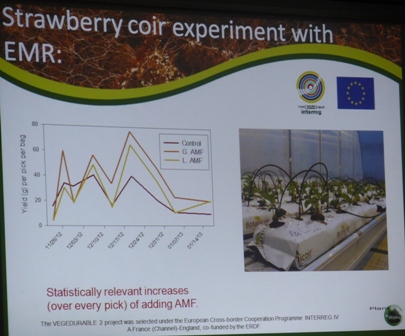
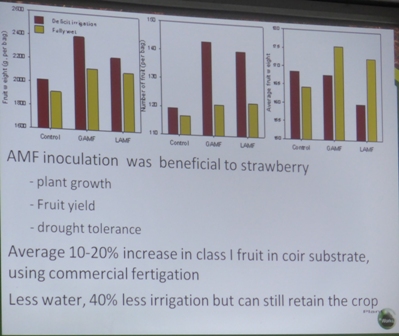
Visit previous English Apple Man Journals covering mycorrhiza...
Click on Journal for 17th February 2012
Click on Journal for 12th December 2014
Click on Journal for 23rd January 2015
In next week's Journal The English Apple Man will report on more topics from The Agrovista Conference and take a look at the influence this winter's weather is having on the potential for the 2016 top fruit crop
Take care
The English Apple Man